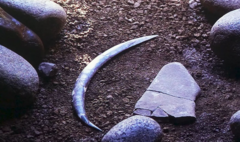The remarkable artifact was excavated from Oblazowa Cave in southern Poland, initially considered to be around 30,000 years old. Recent radiocarbon dating, however, places its age between 39,000 and 42,000 years, shedding light on the advanced skills of early Homo sapiens. The exquisite craftsmanship indicates that this boomerang, with its curved design and size similar to a baseball bat, was likely a tool for hunting rather than one that returned to the thrower.
Dr. Sahra Talamo from the University of Bologna stated that the discovery offers significant insights into the behaviors of our ancestors, suggesting that they possessed the expertise necessary to create such effective tools. The well-preserved boomerang shows signs of having been polished and carved, reflecting personal use by a right-handed individual.
While boomerangs are often linked to Aboriginal culture in Australia, evidence suggests their existence across diverse geographical regions. Previous finds include a 10,500-year-old wooden boomerang from Australia and pieces from Denmark and the Netherlands, illustrating their historical significance beyond one culture.
This research, conducted by an international team of scientists and published in PLOS One, highlights the ingenuity and resourcefulness of ancient peoples and emphasizes the importance of understanding tools like the boomerang in the context of human evolution and adaptation.




















